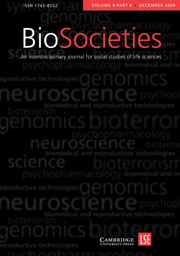Crossref Citations
This article has been cited by the following publications. This list is generated based on data provided by
Crossref.
Newman, William
and
Payne, Katherine
2008.
Removing Barriers to a Clinical Pharmacogenetics Service.
Personalized Medicine,
Vol. 5,
Issue. 5,
p.
471.
Clancy, Tara
2010.
Pharmacogenetics: Making cancer treatment safer and more effective.
p.
147.
Sjögren, Ebba
2010.
Upsetting categories? The consequences of pharmacogenomics for making knowledge-based reimbursement decisions in Sweden.
New Genetics and Society,
Vol. 29,
Issue. 4,
p.
389.
Kohli-Laven, Nina
Bourret, Pascale
Keating, Peter
and
Cambrosio, Alberto
2011.
Cancer clinical trials in the era of genomic signatures: Biomedical innovation, clinical utility, and regulatory-scientific hybrids.
Social Studies of Science,
Vol. 41,
Issue. 4,
p.
487.
Pickersgill, Martyn
2011.
‘Promising’ therapies: neuroscience, clinical practice, and the treatment of psychopathy.
Sociology of Health & Illness,
Vol. 33,
Issue. 3,
p.
448.
O'Riordan, Kate
2011.
Revisiting digital technologies: envisioning biodigital bodies.
Communications,
Vol. 36,
Issue. 3,
Vijverberg, Susanne
Pieters, Toine
and
Cornel, Martina
2012.
Pharmacogenetics and Individualized Therapy.
p.
375.
Tutton, Richard
and
Jamie, Kimberly
2013.
Personalized medicine in context: social science perspectives.
Drug Discovery Today: Therapeutic Strategies,
Vol. 10,
Issue. 4,
p.
e183.
Cox, Helen
and
Webster, Andrew
2013.
Translating biomedical science into clinical practice: Molecular diagnostics and the determination of malignancy.
Health: An Interdisciplinary Journal for the Social Study of Health, Illness and Medicine,
Vol. 17,
Issue. 4,
p.
391.
Hagen, Niclas
Hedlund, Maria
Lundin, Susanne
Mulinari, Shai
and
Kristoffersson, Ulf
2013.
Genetics and democracy—what is the issue?.
Journal of Community Genetics,
Vol. 4,
Issue. 2,
p.
181.
Washburn, Rachel
2013.
Rethinking the disclosure debates: a situational analysis of the multiple meanings of human biomonitoring data.
Critical Public Health,
Vol. 23,
Issue. 4,
p.
452.
Stivers, Tanya
and
Timmermans, Stefan
2017.
The Actionability of Exome sequencing testing results.
Sociology of Health & Illness,
Vol. 39,
Issue. 8,
p.
1542.
Day, Sophie
Coombes, R Charles
McGrath‐Lone, Louise
Schoenborn, Claudia
and
Ward, Helen
2017.
Stratified, precision or personalised medicine? Cancer services in the ‘real world’ of a London hospital.
Sociology of Health & Illness,
Vol. 39,
Issue. 1,
p.
143.
Roberts, Jonathan
and
Middleton, Anna
2018.
Genetics in the 21st Century: Implications for patients, consumers and citizens.
F1000Research,
Vol. 6,
Issue. ,
p.
2020.
Wright, Sarah
Porteous, Mary
Stirling, Diane
Young, Oliver
Gourley, Charlie
and
Hallowell, Nina
2019.
Negotiating jurisdictional boundaries in response to new genetic possibilities in breast cancer care: The creation of an ‘oncogenetic taskscape’.
Social Science & Medicine,
Vol. 225,
Issue. ,
p.
26.
Sun, Shirley
2020.
Clinical usefulness of genetic testing for drug toxicity in cancer care: decision-makers’ framing, knowledge and perceptions.
New Genetics and Society,
Vol. 39,
Issue. 4,
p.
359.
Milne, Richard
Costa, Alessia
and
Brenman, Natassia
2022.
Digital phenotyping and the (data) shadow of Alzheimer's disease.
Big Data & Society,
Vol. 9,
Issue. 1,
Anichini, Giulia
and
Mignot, Léo
2024.
Tensions et convergences dans la conception de nouveaux outils d’intelligence artificielle pour l’oncologie : le cas de la radiomique.
Anthropologie et Santé,
Vol. 28,
Issue. ,


